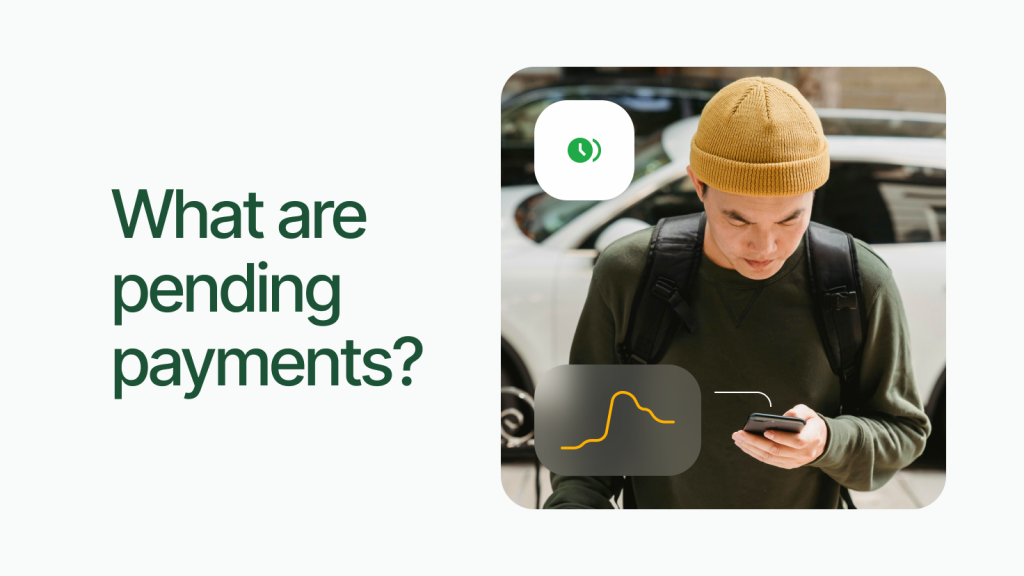Have you ever checked your account or investment platform only to find a payment marked as “pending”? Pending payments can cause some concern, but they are a regular part of financial transactions. Whether you’re dealing with international transfers, banking transactions, or investments on platforms like Mintos, understanding what pending payments are and how they work can help you manage your finances better.
In this article, we’ll explain how pending payments work on Mintos, the reasons they might occur, how they differ from overdue payments, and how you can handle them effectively.
What are pending payments?
On Mintos, pending payments represent money that is currently in the process of being credited to the investor’s account. When a lending company informs Mintos via API that a borrower has made a payment, this payment is assigned a pending payment status. At that point, we only have the notice that a transfer is coming, while we wait for the lending company to actually transfer the money to Mintos. The money is then credited to investors as soon as it arrives.
Pending transactions like these occur because money transfers, especially international ones, take time. This pending payments meaning reflects the normal processing time required for financial institutions to transfer funds between different accounts. The pending payment processing time on Mintos typically involves weekly settlements, where pending payments are resolved as soon as the money is received from the lending company.
If you’re dealing with bank pending payments or credit card pending payments, these typically function similarly. The funds are temporarily on hold until the transaction is fully processed and confirmed by the respective financial institution.
Pending payments status, explained
Pending payments can occur for several reasons, often due to the complexities involved in money transfers, particularly international ones. On Mintos, pending payments are a regularity in the money transfers between investors, Mintos, and lending companies. Here’s a breakdown of some common causes:
- Processing delays. Financial transactions involve multiple parties and systems, which can result in delays. This delay is reflected in the pending payment status shown in your account.
- Verification requirements. Sometimes, additional verification is needed for a transaction to be completed, which can extend the pending payments processing time.
- Batch settlements. On Mintos, pending payments typically occur due to the batch settlement system between Mintos and lending companies. Payments and investments are settled in weekly batches, and the difference is transferred accordingly. During this period, some payments might remain in a pending state until the settlement is finalized. The reason for batch settlements is to maintain cost-efficiency, as transferring small individual amounts separately would incur unnecessary fees.
- Market Conditions: External factors like decreased demand, economic disruptions (e.g., the COVID-19 pandemic), or sanctions can lead to more borrower repayments than new investments in loans. This situation may cause certain payments to remain pending until the lending company transfers the necessary funds to Mintos.
If you encounter common issues with pending payments, it’s often due to one of these factors, and in most cases, the situation will resolve itself once the transaction has completed its process.
How long do pending payments take?
The duration of pending payments varies. On Mintos, the pending payments processing time is typically linked to the weekly settlement system between Mintos and the lending companies.
Normal conditions
Under usual circumstances, the pending payment processing time on Mintos is around 8 days. This is due to the batch settlement process, where payments are only released after the net cash flow between Mintos and the lending company is finalized. If pending transactions are caused by a net outflow from the lending company to Mintos, it may take a few days after the settlement period for the money to be received and the pending payments to be credited to the investor’s account.
Exceptions
In cases where there is a decrease in demand, such as during the COVID-19 pandemic or due to international sanctions, the pending payments might take longer to process. This is because lending companies need to make net transfers to Mintos investors, leading to delays.
Bank pending payments and credit card pending payments
For bank pending payments or credit card pending payments, the time it takes to process can also vary. Typically, it can take anywhere from 1 to 5 business days, depending on the bank or credit card company’s procedures and the nature of the transaction.
While pending payments can be a cause for concern, it’s important to remember that this status simply means the transaction is in process. Monitoring your accounts regularly and understanding the typical timeframes can help you manage your finances more effectively and reduce any anxiety related to pending payments.
Resolving pending payments
If you notice that a transaction is marked as pending for longer than expected, there are several steps you can take to resolve the issue. Here’s how to handle pending payments:
1. Contact the merchant or financial Institution
2. Check for processing times
In some cases, you may want to know how to cancel a pending payment. This is usually only possible if the payment is still within the initial processing phase and has not yet been completed by the merchant. Contact your bank or credit card issuer as soon as possible to inquire about cancellation options.
Resolving pending payments on Mintos
On Mintos, if pending payments persist, monitor the situation through our platform’s Loan statistics page. Mintos has measures in place to ensure that pending payments are not being abused by lending companies, and investors can expect resolution once the funds are transferred from the lending company. For a more personalized view, investors can track their own exposure and case-specific comments on the Overdue page within their account. After 8 days, pending payments are classified as overdue, allowing for more detailed monitoring.
Handling common issues with pending payments
If you experience common issues with pending payments, such as prolonged delays or discrepancies in the amounts, it’s crucial to reach out to customer support for assistance. They can investigate the issue and help expedite the resolution process.
Knowing how to handle pending payments effectively can save you time and reduce frustration. By staying informed and proactive, you can ensure that your funds are processed and credited without unnecessary delays.
Pending payments vs. completed payments
As a quick recap, pending payments are transactions that have been initiated but not fully processed, meaning the funds are on hold and not yet available in your account.
In contrast, completed payments are fully processed transactions where the funds have been successfully transferred and are available in the recipient’s account. On Mintos, a completed payment means the money has been credited to your account and is ready for use or reinvestment.
The processing time for pending payments can vary, often taking several days, especially for international transactions. Completed payments, however, are immediate once all steps are finished, giving you instant access to your funds.
5 common issues with pending payments
While pending payments are a normal part of financial transactions, they can sometimes lead to issues that need to be addressed. Here are some of the most common issues with pending payments that you might encounter:
1. Extended processing times: One of the most frequent concerns is the length of time it takes for pending payments to be completed. While most pending payments resolve within a few days, there are instances where the pending payment status remains for longer, particularly with international transactions or during periods of high market volatility.
2. Bank holds: Pending payments and bank holds often go hand in hand. Banks may place a hold on funds due to regulatory requirements, especially if the payment amount is large or if the transaction seems unusual. This can extend the pending payments processing time significantly.
3. Technical issues: Sometimes, pending payments can be delayed due to technical issues, either on the side of the merchant, the financial institution, or the payment processor. These issues may require intervention from customer support to resolve.
4. Credit card pending payments: With pending payments on credit card, there can be delays caused by additional verification processes, especially for large purchases or if the cardholder’s account has been flagged for suspicious activity.
5. Cancellation challenges: Another issue that can arise is difficulty in learning how to cancel a pending payment. Not all pending payments can be easily canceled, especially once they have begun processing. It’s essential to act quickly and contact your bank or the merchant as soon as possible if you need to cancel a pending payment.
How interest on pending payments is calculated
When pending payments on Mintos extend beyond the standard processing period, investors are compensated with interest. Here’s how the interest on pending payments is calculated:
1. For the first 10 days of a pending payment, no interest is accrued. This is the standard grace period. Please note: This applies only to the interest period. The settlement payments will still be due on day 8 (after the 7-day settlement period) when we expect most of the payments to be transferred to investors.
2. Starting from day 11, interest begins to accrue on the pending payment. The interest rate is 1.2 times the interest rate of the loan or Set of Notes in question.
3. The formula for calculating interest for pending days is: outstanding amount * number of pending days over 10 × interest rate × 1.2 / 360
Example calculation:
- Outstanding amount: €100
- Number of pending days: 20
- Interest rate: 11%
- Using the formula:
Accrued interest for pending days: €100 × (20-10) * 0.11 × 1.2 / 360 = €0.36666
The interest accrued for the 10 pending days beyond the grace period would be approximately €0.37.
The accrued interest is credited to investors after the lending company transfers the funds to Mintos. This ensures that investors are compensated for the delay in receiving their due payments.
Staying on top of pending payments
Pending payments are a regular part of financial transactions, especially in investing. To ensure your financial strategies remain effective, it’s crucial to understand the ins and outs of pending payments and how they can impact your overall investment approach. Whether you’re focused on long-term investments, low-risk investments, or exploring alternative investments, being aware of how pending payments function will help you manage your portfolio with greater confidence.
For those building a passive income stream or engaging in automated investing, knowing when and how your payments are processed is essential for maintaining steady cash flow. Similarly, if your strategy includes risk diversification across different asset classes like real estate investing or crowdfunding, monitoring pending payments becomes an integral part of your financial management.
As you continue to refine your investment strategy, whether you’re setting specific financial goals or exploring short-term investments, keeping track of your pending payments can prevent unexpected delays from disrupting your plans. This attention to detail is particularly important when dealing with complex strategies like ETF investments or factor investing, where timing and liquidity can significantly affect outcomes.
By understanding and managing pending payments effectively, you’re better equipped to navigate the various facets of investing, ensuring that your funds are available when needed and that your financial strategies continue to operate smoothly.
Disclaimer:
This is a marketing communication and in no way should be viewed as investment research, investment advice, or recommendation to invest. The value of your investment can go up as well as down. Past performance of financial instruments does not guarantee future returns. Investing in financial instruments involves risk; before investing, consider your knowledge, experience, financial situation, and investment objectives.

